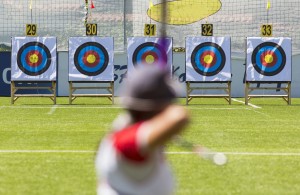Work doesn’t have to stop  once you leave the office at 5:00 p.m. And if you’re as curious as our Lab Manager and Safety Manager, Alan Sentman, you’re always looking for new ways to solve problems. Alan was watching Olympic archery last week when he began thinking – could he calculate the likelihood of the United States winning a gold medal over their opponent, South Korea, in the archery finals? To be blunt, the answer is yes, but it was a long shot (pun intended). Let’s break it down.
once you leave the office at 5:00 p.m. And if you’re as curious as our Lab Manager and Safety Manager, Alan Sentman, you’re always looking for new ways to solve problems. Alan was watching Olympic archery last week when he began thinking – could he calculate the likelihood of the United States winning a gold medal over their opponent, South Korea, in the archery finals? To be blunt, the answer is yes, but it was a long shot (pun intended). Let’s break it down.
Alan compiled an Excel sheet of shots the competitors took throughout the quarterfinals, semifinals and finals of the Olympics. Using the pseudorandom numbers from Excel and Monte Carlo analysis (used to account for risk in quantitative analysis) he was able to model several thousand matches including up to three rounds of tie breakers, and came up with the statistical likelihood of the United States or South Korea winning gold. When it was all said and done, the Excel sheet had over 10,000 rows of data – yes you read that right.
South Korea was the favorite in the finals, and did end up winning gold. According the Alan’s data, the United States had approximately a four percent chance of winning, compared to South Korea’s 96 percent. This is assuming that the 50 to 60 shots for each team from the initial data are a fair representation of the teams overall shooting.
Athletes practice for years to prepare for the Olympics. However, for some sports athletes get one chance to give it their best, and things don’t always go as planned. So, how does this relate to the work we do at PSI? Unexpected results can and do occur when testing materials and devices, and it’s our job to mitigate the chances of this happening. When our scientists conduct routine analysis for a client they may analyze several hundred samples per year. Even if nothing is wrong with the material, equipment, or method, there may be an occasional outlier that may not be what we, or our client, anticipated. On the other hand unusual results may indicate an issue with something in the lab. Our scientists use validation when developing a new method to help understand method precision and recognize outliers when testing samples.
So while it wasn’t impossible, the statistical odds weren’t in the United States favor during the archery finals. But there was still a slight possibility of the team clenching the gold. And just like in the lab, unexpected results can occur, even if the likelihood is extremely small. That’s why it’s important to consider unanticipated results, and ensure protocol is in place for when the unexpected happens.
*Data accuracy was not confirmed by the PSI team—since this analysis was done for fun, on Alan’s own time, to satisfy his curiosity!
